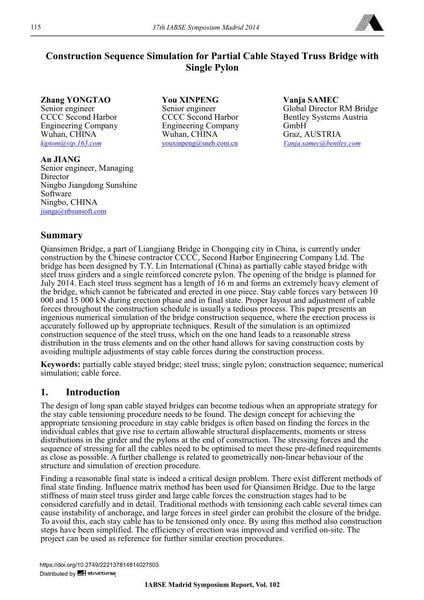Construction Sequence Simulation for Partial Cable Stayed Truss Bridge with Single Pylon

|
|
|||||||||||
Détails bibliographiques
| Auteur(s): |
Zhang Yongtao
You Xinpeng Vanja Samec An Jiang |
||||
|---|---|---|---|---|---|
| Médium: | papier de conférence | ||||
| Langue(s): | anglais | ||||
| Conférence: | IABSE Symposium: Engineering for Progress, Nature and People, Madrid, Spain, 3-5 September 2014 | ||||
| Publié dans: | IABSE Symposium Madrid 2014 | ||||
|
|||||
| Page(s): | 115-122 | ||||
| Nombre total de pages (du PDF): | 8 | ||||
| Année: | 2014 | ||||
| DOI: | 10.2749/222137814814027503 | ||||
| Abstrait: |
Qiansimen Bridge, a part of Liangjiang Bridge in Chongqing city in China, is currently under construction by the Chinese contractor CCCC, Second Harbor Engineering Company Ltd. The bridge has been designed by T.Y. Lin International (China) as partially cable stayed bridge with steel truss girders and a single reinforced concrete pylon. The opening of the bridge is planned for July 2014. Each steel truss segment has a length of 16 m and forms an extremely heavy element of the bridge, which cannot be fabricated and erected in one piece. Stay cable forces vary between 10 000 and 15 000 kN during erection phase and in final state. Proper layout and adjustment of cable forces throughout the construction schedule is usually a tedious process. This paper presents an ingenious numerical simulation of the bridge construction sequence, where the erection process is accurately followed up by appropriate techniques. Result of the simulation is an optimized construction sequence of the steel truss, which on the one hand leads to a reasonable stress distribution in the truss elements and on the other hand allows for saving construction costs by avoiding multiple adjustments of stay cable forces during the construction process. |
||||
